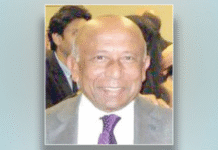A. Rahman
There had recently been a strong surge of presumed religiosity or, more accurately, mimicking of religiosity and religious dress code among the Muslim women (as well as in men) in the West as well as in the East. Although Muslim women for decades in the East as well in the West (save Middle East) considered themselves free from strict religious enforcement of dress code, recently they flipped and tended to adhere to the presumed religious dress code – burqa or niqab or hijab. This trend which started some 15 or 20 years ago has now gained added momentum and become a part of religious obligation.
The Muslim women in the West, particularly in France, had so adamantly upheld their religious rights to put on burqa or niqab that the French government found it necessary to pass a law on ‘religious headgear’ in 2010 banning wearing such attire – burqa or niqab or hijab. When this law was challenged by Muslin human rights group in the European Court of Human Rights at Strasbourg, the Court upheld the French government’s ban in its ruling on 1 July 2014 by saying that the law does not breach Muslim women’s Human Rights and consequently there is no reason why the ban should not be upheld. This is a landmark ruling and it could prompt other countries of the world to consider banning such attires without the risk of legal challenges.
Before considering the issue of religious obligation on wearing burqa or niqab, as claimed by the devout followers of Islam, let us look at different dresses that are stated to be specified in Quran and Hadith. The “burqa” is a garment for women to cover the whole of the woman’s body, from head to toe, with a mesh cloth only over the part of the eyes in order to see. A burqa is normally made of black cloth; but recently other colours are also used. A “niqab” is similar to a burqa but with a thin slit, instead of mesh cloth, for the eyes. A niqab is also predominantly black in colour. The “hijab” is, on the other hand, a headgear that is wrapped around the head covering head, neck and shoulder with only face exposed.
There is controversy as to what Islam directs women to wear. Some religious scholars argue that hijab is obligatory; whereas others disagree and assert that niqab is. But the fact is that women in the Arab Peninsula used to wear niqab and burqa well before Islam came into being. Islam adopted that practice as a continuation of prevailing customs. There is no unambiguous statement directing Muslim women to wear niqab or burqa. With regard to hijab, Prophet Mohammad wanted only his wives to wear hijab to distinguish them from other women and to indicate to other people to show respect to them. There was no obligation in the religious edicts to copy Mohammad’s wives’ attire.
So why do Muslim women suddenly feel obliged to wear niqab or burqa or some other similar attire? How did these religious obligations come about now, which were not there even 20 years ago? Does this claim of infringement of human rights (by French Muslim women) stack up against the demands to conceal women in public by covering them from head to toe? Isn’t this concealment itself an infringement of human rights, as it epitomises the servitude of women to men and thereby reneging equality of sex? Admittedly, in Bangladesh and in India, poor and illiterate village women used to wear burqa for generations. But that practice was limited and definitely not prevalent in the middle class families or in the cities.
The Universal Declaration of Human Rights (UDHR) was framed by the Human Rights Commission at the end of World War II and that was adopted by the United Nations General Assembly in 1948. In the Preamble of the declaration, it stated that ‘in recognition of the inherent dignity and of the equal and inalienable rights of all members of the human family’, this declaration had been adopted. It covered various aspects of human rights such as rights to education, health, liberty, security, nationality and above all human dignity. This convention was signed by 48 States at that time, but Saudi Arabia and some other orthodox Muslim States refused to sign it as they disagreed with Article 16 (which dealt with ‘equal rights to men and women in marriage’) on grounds of religion. In Islam, women are subservient to men in marriage – both in status and family hierarchy. However, in 2008 the Organisation of Islamic Conference (OIC) accepted the convention and so these fundamentalist countries, being members of the OIC, had adopted de facto the provisions of the UDHR.
But in reality most of these Muslim countries had been flouting, to varying degrees, the human rights to women to adhere to religious edicts. In Islam, women are required to be confined within the homes of their parents and then of their husbands. Women are not allowed to go out in public without being accompanied by their fathers or brothers and after marriages by husbands. Women are not allowed to be educated beyond the basic levels to read, write and keep accounts of family expenses. Women are not allowed to drive cars (modern interpretation by Saudi Wahhabism). Men and women are not treated as equal in Islam – women inherit half of what man can inherit; women are subservient to men (husbands) in the family; husbands can divorce wives at will (without showing any cause) but women cannot etc. – and so giving ‘equal rights to men and women in marriage’ in UDHR goes against the basic tenets of Sharia Law of the religion. Men can marry four times and keep four wives concurrently; but women cannot even ask for divorce. Women are kept indoors and when they go out with their husbands, they are to be fully veiled.
So under the circumstances, when fundamentalist Muslim women assert that denying them their rights to wear niqab or burqa is unacceptable as it is an infringement of their human rights, one finds it hollow and vacuous; particularly when so many other more important human rights are denied in religion. There are a number of issues which need to be considered when addressing pros and cons of allowing burqa and niqab to be worn by Muslim women and these are:
- If Muslim women are religiously so orthodox and sanctimonious to feel religious obligations to wear these attires, they should not defy other obligations in Islam such as not going out of their homes without being accompanied by their fathers or husbands. It should, however, be noted that the religion did not prescribe wearing burqa or niqab obligatory. Even if such attires are presumed to be obligatory, these women cannot selectively choose which obligation they would follow and which ones they would flout.
- Wearing such attires by Muslim women is claimed to be part of their culture. Hardly do they know that wearing such attire was the culture of the Arab Bedouins, not Bangladeshi or Indian culture. In fact, sari to Indian subcontinent women is what niqab to Bedouins women. In the Western countries also, Muslim women claim such attire as part of their religious identity. In reality, these women carry forward such concocted identity from their home countries and then force it on to the host society. Such assertion arises as a result of aggressive Wahhabism which is being propagated from Saudi Arabia with financial support and religious sponsorship. In a liberal and secular country, such proclaimed religious imposition is offensive and derogatory to the indigenous culture of the country.
- A political religious culture of Islam does not go well with liberal democratic and secular system. Rights to perform religious rites are enshrined in the law of the land, but that does not mean that all rights arising from Sharia Laws, in defiance of the democratic laws, should be adhered to. If religious laws encourage abrogation of laws of the land, then those laws need to be considered to be rejected by the State.
- Women wearing niqab or burka are now passing on such practices to their daughters – even to school going girls. It is a common sight now-a-days that Muslim girls of the age of ten or eleven going to primary schools wear these attires. By encouraging and enforcing such dresses on school going daughters, they segregate these girls from the wider community.
In view of all these points, the government of Bangladesh having secularism enshrined in the constitution should consider following the French precedence — which enforced the ban more than three years ago. The liberal democratic system allowing individual freedom of speech, freedom of expression etc. is fine, but there must be limits to such freedom, particularly when there is an undeniable tendency to take advantage of it. If Sharia Law is attempted to be introduced surreptitiously under the guise of religious freedom, then such attempts should be considered to be thwarted; otherwise bigger problems may arise in future which may threaten the very fabric of the society.
Source: Bd news24











What a piece of trash! I really don’t understand why all the noise when Muslim women want to exercise their religious right of wearing hijab when no one says anything about women of the “civilized nations” going about half naked in bikinis and getting raped in the process. My question to the writer of the article – would you like your mother, wife, sister and daughter to be raped in the pretext of exercising their ” human rights” or “equal rights” for women? Who are the people that drafted the UDHR in 1948? A woman is raped every 2 minutes in the USA. I would rather hide my woman than to “liberate” them only to be used as a cheap commodity to be consumed by the greedy consumer of the “democratic free economic system”. Good try Mr.A.Rahman. Try something else next time.